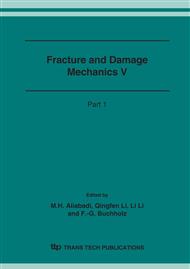p.25
p.29
p.33
p.39
p.43
p.47
p.51
p.55
p.59
A Damage Model Containing Delamination in Composite Laminates
Abstract:
When stress is high, delaminate damage can be induced by transverse cracks. A complete parabolic shear-lag damage model containing delamination induced by transverse cracks is therefore proposed and applied to predict the stiffness reduction by transverse cracking in cross-ply laminated composite materials. The predictions of the complete parabolic shear-lag analysis model, the incomplete parabolic shear-lag analysis model, and the complete parabolic shear-lag damage model containing delamination proposed in this paper have been compared. Results show that the young’s modulus reduction values obtained by our analysis model are better agreement with the experimental ones than other models.
Info:
Periodical:
Pages:
43-46
Citation:
Online since:
November 2006
Authors:
Price:
Сopyright:
© 2006 Trans Tech Publications Ltd. All Rights Reserved
Share:
Citation:


